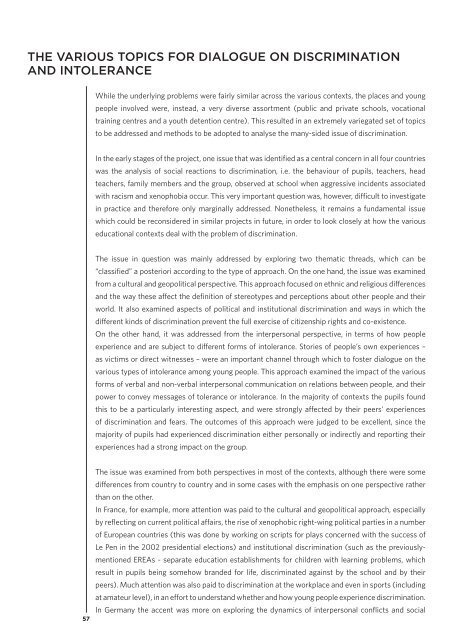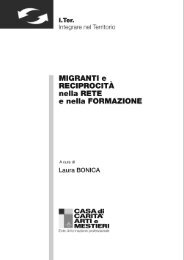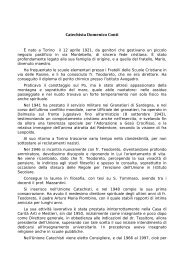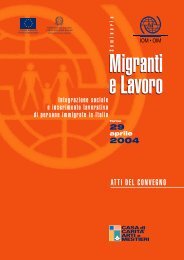Rapporto finale/ Final Report (ITA-ENG) - Casa di Carità Arti e Mestieri
Rapporto finale/ Final Report (ITA-ENG) - Casa di Carità Arti e Mestieri
Rapporto finale/ Final Report (ITA-ENG) - Casa di Carità Arti e Mestieri
Create successful ePaper yourself
Turn your PDF publications into a flip-book with our unique Google optimized e-Paper software.
THE VARIOUS TOPICS FOR DIALOGUE ON DISCRIMINATION<br />
AND INTOLERANCE<br />
57<br />
While the underlying problems were fairly similar across the various contexts, the places and young<br />
people involved were, instead, a very <strong>di</strong>verse assortment (public and private schools, vocational<br />
training centres and a youth detention centre). This resulted in an extremely variegated set of topics<br />
to be addressed and methods to be adopted to analyse the many-sided issue of <strong>di</strong>scrimination.<br />
In the early stages of the project, one issue that was identified as a central concern in all four countries<br />
was the analysis of social reactions to <strong>di</strong>scrimination, i.e. the behaviour of pupils, teachers, head<br />
teachers, family members and the group, observed at school when aggressive incidents associated<br />
with racism and xenophobia occur. This very important question was, however, <strong>di</strong>fficult to investigate<br />
in practice and therefore only marginally addressed. Nonetheless, it remains a fundamental issue<br />
which could be reconsidered in similar projects in future, in order to look closely at how the various<br />
educational contexts deal with the problem of <strong>di</strong>scrimination.<br />
The issue in question was mainly addressed by exploring two thematic threads, which can be<br />
“classified” a posteriori accor<strong>di</strong>ng to the type of approach. On the one hand, the issue was examined<br />
from a cultural and geopolitical perspective. This approach focused on ethnic and religious <strong>di</strong>fferences<br />
and the way these affect the definition of stereotypes and perceptions about other people and their<br />
world. It also examined aspects of political and institutional <strong>di</strong>scrimination and ways in which the<br />
<strong>di</strong>fferent kinds of <strong>di</strong>scrimination prevent the full exercise of citizenship rights and co-existence.<br />
On the other hand, it was addressed from the interpersonal perspective, in terms of how people<br />
experience and are subject to <strong>di</strong>fferent forms of intolerance. Stories of people’s own experiences –<br />
as victims or <strong>di</strong>rect witnesses – were an important channel through which to foster <strong>di</strong>alogue on the<br />
various types of intolerance among young people. This approach examined the impact of the various<br />
forms of verbal and non-verbal interpersonal communication on relations between people, and their<br />
power to convey messages of tolerance or intolerance. In the majority of contexts the pupils found<br />
this to be a particularly interesting aspect, and were strongly affected by their peers’ experiences<br />
of <strong>di</strong>scrimination and fears. The outcomes of this approach were judged to be excellent, since the<br />
majority of pupils had experienced <strong>di</strong>scrimination either personally or in<strong>di</strong>rectly and reporting their<br />
experiences had a strong impact on the group.<br />
The issue was examined from both perspectives in most of the contexts, although there were some<br />
<strong>di</strong>fferences from country to country and in some cases with the emphasis on one perspective rather<br />
than on the other.<br />
In France, for example, more attention was paid to the cultural and geopolitical approach, especially<br />
by reflecting on current political affairs, the rise of xenophobic right-wing political parties in a number<br />
of European countries (this was done by working on scripts for plays concerned with the success of<br />
Le Pen in the 2002 presidential elections) and institutional <strong>di</strong>scrimination (such as the previouslymentioned<br />
EREAs - separate education establishments for children with learning problems, which<br />
result in pupils being somehow branded for life, <strong>di</strong>scriminated against by the school and by their<br />
peers). Much attention was also paid to <strong>di</strong>scrimination at the workplace and even in sports (inclu<strong>di</strong>ng<br />
at amateur level), in an effort to understand whether and how young people experience <strong>di</strong>scrimination.<br />
In Germany the accent was more on exploring the dynamics of interpersonal conflicts and social







